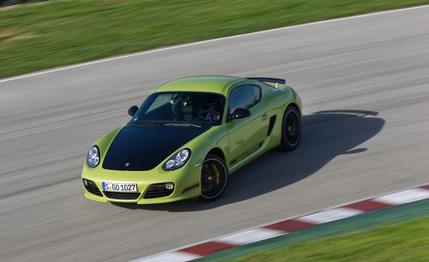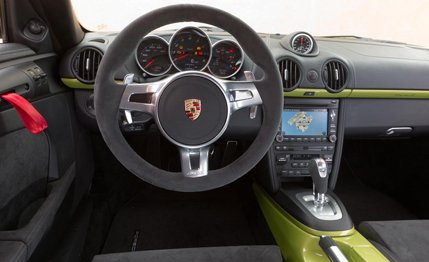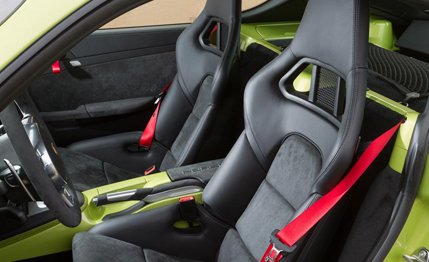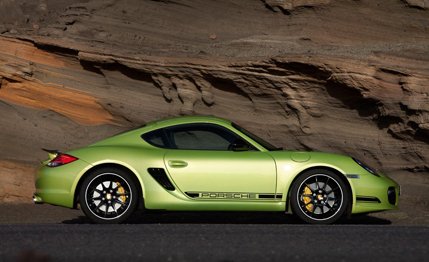
 First Drive Review
First Drive Review
As much as the 911 is the brand’s unquestioned icon, Porsche executives freely admit that the mid-engine layout of the Boxster and Cayman is the dynamically superior concept. To protect the 911, Porsche has diligently kept a performance gap between the top-of-the-line Cayman and entry-level 911—a gap in straight-line performance, that is. But now, as the Cayman and the 997 911 are well in the autumn of their product cycles, the smaller car has been let off its leash.
History-Wrapped Lightness
You notice the new Cayman R’s aesthetic distinctions immediately. Porsche plays on the historic racing theme once again through the use of specific lettering and stripes on the R’s flanks, as well as a fixed rear wing that references the 1967 911R, of which only 19 were built. The competition often struggles to integrate history into its sporty offerings, but all Porsche needs to do is add another letter and a few stripes to send its loyalists into hysterics.


That, of course, is not all. The Cayman R has gained 10 hp over its Cayman S sibling—for a total of 330 available at a lofty 7400 rpm—thanks to a freer-flowing exhaust system. Even more important, Porsche claims the R sheds a cool 121 pounds, making it one of the lightest sports cars on the market. How was this accomplished? The aluminum doors shave off 33 pounds, 26 pounds come from the use of lighter seat structures, and 11 pounds from new wheels. The rest is in the details, such as the fabric straps that replace conventional door pulls and the nonactuated rear wing. If you can do without air conditioning and a radio, subtract another 26 and seven pounds. The carbon-ceramic brakes—an $8150 option—will shave off another seven pounds, and the available lithium-ion starter battery ($1700) is worth 26. These weight-saving measures are much the same as those employed on this car’s open-roofed foil, the Boxster Spyder.
Zen and the Art of Mid-Engine Porsches
Like any Cayman, the R imparts an instant sensation of man-machine harmony as soon as you get behind the wheel. Looking around, we note the interior is purposeful and clean, if a bit dated.
The precision with which any throttle, brake, and steering input is delivered dynamically is virtually unmatched. It’s a sharpness that sets the Cayman R apart from its lesser siblings.


That’s not least thanks to a lower center of gravity and a modified chassis with a reduced roll-angle gradient. The aerodynamics are improved as well: Rear-axle lift is reduced 40 percent, front-axle lift has been lowered by 15 percent. The steering is perfectly weighted, neither light nor artificially heavy. The naturally aspirated flat-six is supremely responsive and attentive to the slightest input, a behavior unmatched by any turbocharged engine. At the limits of adhesion, the Cayman R is remarkably communicative and a pleasure to handle. It allows the driver to probe those limits fully, as the stability-control system can be turned off completely.
In standard configuration, the power is transmitted to the rear wheels through a six-speed manual transmission with nicely spaced ratios. Those who prefer not to shift for themselves might appreciate the fact that the optional seven-speed PDK dual-clutch automatic (which comes with a 55-pound penalty) has a modified and sportier shifting strategy in its normal and sport modes. Sport plus, which Porsche says is strictly for the track but which we appreciate on open roads as well, remains unchanged. It is our favorite setting as it doesn’t try to interpret the pilot’s driving style and therefore is utterly predictable.


Straight-line performance is impeccable. At an ungoverned 175 mph and with a predicted 0-to-60-mph time of just over four seconds, the Cayman R should leave much more powerful cars in the dust. Acceleration runs are accompanied by an angry blare, although we’d prefer it to be even more assertive. But it still sounds great.
The Cayman R is not a compact equivalent of the radical GT3 RS—you could easily use this car on a long trip—but it is a better, slightly faster Cayman that remains faithful to the established formula. True, it and the Boxster Spyder inch uncomfortably close to the entry-level 911 models. But if any brand can handle a little internal competition, it’s Porsche.